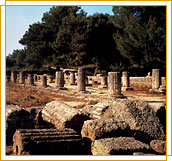Olympia during the 7th-6th century BC
Elis' authority and power declined during the 7th century BC after a series of conflicts with its neighbors, particularly the Pisatans on the south.  The Pisatans occupied the sanctuary, assumed its control in 676 BC and until the end of the 7th century BC organized the games. The Pisatans occupied the sanctuary, assumed its control in 676 BC and until the end of the 7th century BC organized the games.
The first indications of building activity in Olympia date from the beginning of the 6th century BC. At the same time the cult of Hera appeared at Olympia and a large Doric temple dedicated to her was erected. According to tradition, it was built in the Altis in around 600 BC and its donors were the Skiloundians, the allies of the Pisatans who had control of the sanctuary during that period. It is one of the oldest examples of a peripteral temple in antiquity in Greece, with an oblong facade, 6 columns on the narrow side and 16 on the long one. In the cella, which was divided into three aisles, were the stone statues of Zeus and Hera. The ancient traveler Pausanias, who visited the area in the 2nd century BC, mentioned that a column in the opisthodomos of the temple was made of wood. Apparently, the columns were initially made of wood and were gradually replaced with stone ones.
The Pelopion lay south of the Heraion and was the cenotaph of Pelops, the legendary founder of the games. The tomb was shaped in around 1100 BC and was renovated in the 6th century BC with the addition of an enclosure, where the faithful honored the hero by sacrificing a black ram. The Treasuries, which date from the same period, were temple-shaped buildings on a terrace, constructed by the representatives of the Greek cities that participated in the games for the safekeeping of valuable offerings. They were built on the north side of the sanctuary, at the foothill of the Cronios hill. Sikyon was the first city to dedicate a Treasury, while the other cities that followed its example were -in the order of the buildings that are preserved from west to east- Syracuse, Byzantium, Sybaris, Cyrene, Selinus, Metapontium, Megara, Gela.
In addition, secular buildings and athletic facilities were constructed. The Bouleuterion was the seat of the supreme council, which was responsible for all the issues related with the sanctuary and the games. It consisted of two oblong buildings with interior colonnades. Nearby were the altar and the statue of Zeus Orkios (Zeus of the Oath), where athletes took an oath in the first day of the games.
The Stadium was constructed in around 560 BC. It was a simple track, with no embankments, on the southern slope of the Cronios hill. Its starting point was placed on the narrow, western slope, with a view towards the large altar of Zeus. Soon it was replaced with a new Stadium, erected in around 500 BC, almost at the exact spot, but slightly shifted to the east, in order to create space suitable for worshipping to the east of the altar of Zeus. Its remodeling indicates the increased number of visitors to the sanctuary during this period.
In the same period the chariot race and other equestrian events were introduced to the Olympic program, probably in honor of the victory of the Mycenaean hero Pelops over Oinomaos, which were something of a tradition in nearby Pisa. In 580 BC, Elis allied with Sparta, occupied Pisa and regained control of the sanctuary and retained it until the last Olympic games. The period from 580 BC to the end of the 5th century BC has been the most peaceful period of this region.
|
